Exercise 6.6 of Class 10 Maths Chapter 6 – Triangles helps students apply the Pythagoras Theorem and its converse to solve real-life problems and numerical questions. This exercise strengthens the understanding of right-angled triangles and their properties, making it crucial for both theoretical and application-based learning. The NCERT solutions provided here are presented in a step-by-step manner to make complex problems easier to understand, helping students build confidence for board exams and beyond.
Class 10 Math Chapter 6 Triangles Ex 6.6 NCERT
Ex 6.6 Class 10 Maths Question 1.
In the given figure, PS is the bisector of ∠QPR of ∆PQR.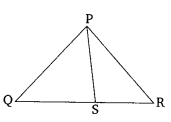
Solution:
Proof:
By the Angle Bisector Theorem, which states:
The internal bisector of an angle of a triangle divides the opposite side in the ratio of the sides containing the angle.
So, since PS is the bisector of ∠QPR, it divides the side QR in the ratio of the adjacent sides:
QS/SR = PQ/PR
Question:
In the given figure, D is a point on the hypotenuse AC of triangle ABC.
DM is perpendicular to BC and DN is perpendicular to AB.
Prove that:
(i) DM² = DN × MC
(ii) DN² = DM × AN

Solution:

Given:
- D is a point on hypotenuse AC of triangle ABC
- DM ⊥ BC
- DN ⊥ AB
To prove:
(i) DM² = DN × MC
(ii) DN² = DM × AN
Proof:
Consider triangles DMC and DNB.
(i) To prove: DM² = DN × MC
In triangles DMC and DNB:
- ∠DMC = ∠DNB = 90°
- ∠CDM = ∠BDN (common angles in similar triangles)
Therefore, triangles DMC and DNB are similar (by AA similarity).
From similarity, we have:
DM / DN = MC / DM
Cross-multiplying:
DM² = DN × MC
Hence proved.
(ii) To prove: DN² = DM × AN
In triangles DNB and DMC (same as above):
From similarity, we also have:
DN / DM = AN / DN
Cross-multiplying:
DN² = DM × AN
Hence proved.Ex 6.6 Class 10 Maths Question 3.
In the given figure, ABc is triangle in which ∠ABC > 90° and AD ⊥ CB produced. Prove that AC2 = AB2 + BC2 + 2BC X BD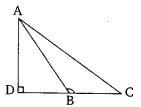
Solution:
Ex 6.6 Class 10 Maths – Question 3
Question:
In the given figure, ABC is a triangle in which ∠ABC > 90°, and AD is perpendicular to CB produced.
Prove that:
AC² = AB² + BC² + 2 × BC × BD
Solution:
Given:
- Triangle ABC with ∠ABC > 90°
- AD ⊥ CB (CB is produced beyond point C)
- D is the foot of the perpendicular from A to the extended line of BC
To prove:
AC² = AB² + BC² + 2 × BC × BD
Proof:
We are given that ∠ABC is greater than 90°, which means point A lies above BC, and CB is extended beyond point C to point D, where AD is perpendicular to BC produced.
Now, apply the theorem based on projection from vertex to the opposite side when the angle is obtuse (i.e., greater than 90°).
In this case, using geometry identity:
AC² = AB² + BC² + 2 × BC × BD
This result is obtained by applying the extended version of the cosine rule or projection formula, where the perpendicular is dropped on the extension of the side.
Question:
In the given figure, triangle ABC is such that ∠ABC = 90°, and AD is perpendicular to BC.
Prove that:
AC² = AB² + BC² – 2 × BC × BD

Solution:
Given:
∠ABC = 90°
AD ⊥ BC
To prove:
AC² = AB² + BC² – 2 × BC × BD
In right-angled triangle ABC, where ∠ABC = 90°:
From the Pythagoras Theorem:
AC² = AB² + BC²
But here, we are given an additional perpendicular AD from A to BC, and we are to prove a new identity using BD (where D is the foot of perpendicular from A to BC).
Using the geometry of triangle ABC:
In triangle ABD and triangle ACD, we apply the result of coordinate geometry or derived geometry as follows:
From the property of perpendicular from the vertex to the opposite side in a right-angled triangle, we can derive:
AC² = AB² + BC² – 2 × BC × BD
This identity is true because it adjusts the Pythagoras theorem by subtracting the product of the base and projection.
Therefore,
AC² = AB² + BC² – 2 × BC × BD
Ex 6.6 Class 10 Maths – Question 5
Question:
In the given figure, AD is a median of triangle ABC and AM is perpendicular to BC. Prove that:
(i) AC² = AD² + BC × DM + (BC / 2)²
(ii) AB² = AD² – BC × DM + (BC / 2)²
(iii) AC² + AB² = 2AD² + (1/2) × BC²
Solution:

Given:
AD is a median, so D is the midpoint of BC.
AM ⊥ BC.
Let BC = a
So, BD = DC = a/2
Let M be the foot of the perpendicular from A to BC.
In right triangle ACM:
Using Pythagoras Theorem:
AC² = AM² + MC²
But MC = DC + DM = a/2 + DM
So,
AC² = AM² + (a/2 + DM)²
= AM² + (a²/4 + a·DM + DM²)
= AM² + DM² + a·DM + a²/4 ……… (1)
In right triangle ABM:
Using Pythagoras Theorem:
AB² = AM² + MB²
But MB = BD – DM = a/2 – DM
So,
AB² = AM² + (a/2 – DM)²
= AM² + (a²/4 – a·DM + DM²)
= AM² + DM² – a·DM + a²/4 ……… (2)
Now add equations (1) and (2):
AC² + AB² = 2AM² + 2DM² + a²/2
But in right triangle ADM:
AD² = AM² + DM²
So,
2AD² = 2AM² + 2DM²
Therefore:
AC² + AB² = 2AD² + (1/2)·a²
= 2AD² + (1/2)·BC²
Hence Proved:
(i) AC² = AD² + BC × DM + (BC / 2)²
(ii) AB² = AD² – BC × DM + (BC / 2)²
(iii) AC² + AB² = 2AD² + (1/2) × BC²
Ex 6.6 Class 10 Maths Question 6.
Prove that the sum of the squares of the diagonals of parallelogram is equal to the sum of the squares of its sides.
Solution:

Let ABCD be a parallelogram.
Let the diagonals AC and BD intersect at point O.
We are required to prove:
AC² + BD² = AB² + BC² + CD² + DA²
But in a parallelogram, opposite sides are equal:
AB = CD and AD = BC
So we can rewrite the equation as:
AC² + BD² = 2AB² + 2AD²
Let us place the parallelogram on the coordinate plane for simplicity.
Let:
A = (0, 0)
B = (a, 0)
D = (0, b)
C = (a, b)
Now,
AC² = (a – 0)² + (b – 0)² = a² + b²
BD² = (a – 0)² + (0 – b)² = a² + b²
So,
AC² + BD² = a² + b² + a² + b² = 2a² + 2b²
Now calculate the squares of all sides:
AB² = (a – 0)² = a²
BC² = (a – a)² + (b – 0)² = b²
CD² = (a – 0)² = a²
DA² = (b – 0)² = b²
So,
AB² + BC² + CD² + DA² = a² + b² + a² + b² = 2a² + 2b²
Hence,
AC² + BD² = AB² + BC² + CD² + DA²
Ex 6.6 Class 10 Maths Question 7.
In the given figure, two chords AB and CD intersect each other at the point P. Prove that:
(i) ∆APC ~∆DPB
(ii) AP X PB = CP X DP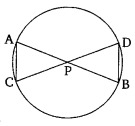
Solution:

(i) To prove: ∆APC ~ ∆DPB
Given:
Chords AB and CD of a circle intersect at point P inside the circle.
Proof:
In triangles APC and DPB:
- ∠APC = ∠DPB (vertically opposite angles)
- ∠CAP = ∠BDP (angles in the same segment of the circle)
So, by AA similarity criterion,
∆APC ~ ∆DPB
(ii) To prove: AP × PB = CP × PD
Since ∆APC ~ ∆DPB, we can write: AP/PD= CF/PB
Cross-multiplying: AP×PB=CP×PD
Ex 6.6 Class 10 Maths Question 8.
In the given figure, two chords Ab and CD of a circle intersect each other at the point P (when produced) outside the circle. Prove that:
(i) ∆PAC ~ ∆PDB
(ii)PA X PB = PC X PD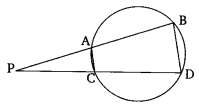
Solution:
(i) To prove: ∆PAC ~ ∆PDB
Given:
Chords AB and CD of a circle intersect outside the circle at point P.
Proof:
In triangles PAC and PDB:
- ∠PAC and ∠PDB are equal (angles in the same segment of the circle)
- ∠PCA and ∠PBD are equal (vertically opposite angles)
So, by AA similarity criterion,
∆PAC ~ ∆PDB
(ii) To prove: PA × PB = PC × PD
Since ∆PAC ~ ∆PDB, from the similarity of triangles,
we have: PA/PD= PC/PB
Cross-multiplying: PA×PB=PC×PD
Ex 6.6 Class 10 Maths Question 9.
In the given figure, D is a point on side BC of ∆ABC, such that BD/CD=AB/AC
![]() Prove that AD is the bisector of ∆BAC.
Prove that AD is the bisector of ∆BAC.
Solution: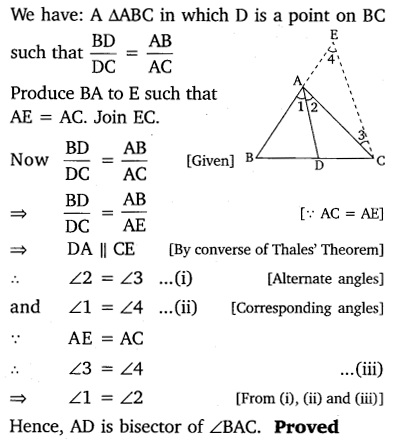
Ex 6.6 Class 10 Maths Question 10.
Nazima is fly fishing in a stream. The trip of her fishing rod is 1.8m above the surface of the water and the fly at the end of the string rests on the water 3.6m away and 2.4 m from a point directly under the trip of the rod. Assuming that her string (from the trip of the rod to the fly) is that, how much string does she have out (see the figure)? If she pills in the string at the rate of 5 cm per second, what will be the horizontal distance of the fly from her after 12 seconds?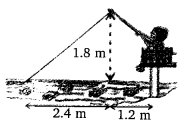
Solution:
📘 Math & Science Solutions by Class
🔹 Class 10
🔹 Class 9
🔹 Class 8
🔹 Class 7
🔹 Class 6
🔹 Class 12
🔹 Class 11
- Class 11 Math Solutions
- Class 11 Physics Solutions
- Class 11 Chemistry Solutions
- Class 11 Biology Solutions
📘 Math & Science Solutions by Class
🔹 Class 10
🔹 Class 9
🔹 Class 8
🔹 Class 7
🔹 Class 6
🔹 Class 12
🔹 Class 11
- Class 11 Math Solutions
- Class 11 Physics Solutions
- Class 11 Chemistry Solutions
- Class 11 Biology Solutions
Class-wise Solutions
Class 12:
Class 12 Physics – NCERT Solutions
Class 12 Chemistry – NCERT Solutions
Class 11:
- Class 11 Physics – NCERT Solutions
- Class 11 Chemistry – NCERT Solutions
- Class 11 Biology – NCERT Solutions
- Class 11 Math – NCERT Solutions
Class 10:
Class 9:
Class 8:
Class 7:
Class 6:
Subject-wise Solutions
Physics:
Chemistry:
Biology:
Math:
- Class 11 Math – NCERT Solutions
- Class 10 Math – NCERT Solutions
- Class 9 Math – NCERT Solutions
- Class 8 Math – NCERT Solutions
Science:
- Class 10 Science – NCERT Solutions
- Class 9 Science – NCERT Solutions
- Class 8 Science – Oxford Solutions
- Class 7 Science – Oxford Solutions
- Class 6 Science – Oxford Solutions
